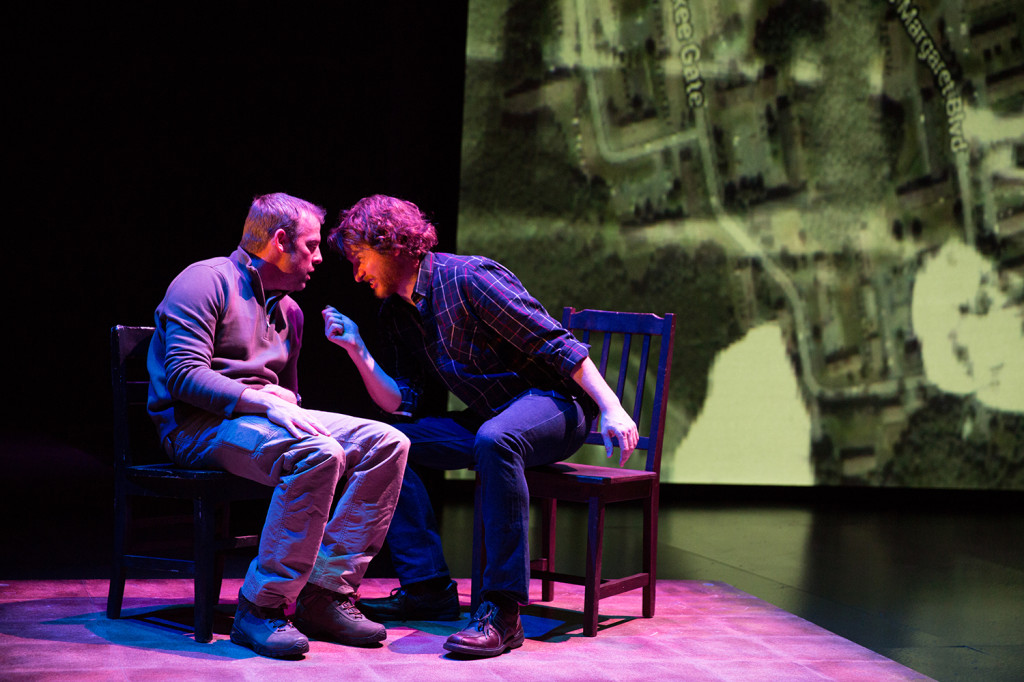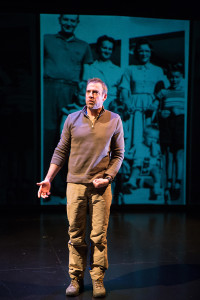
PAUL WATSON: Do you believe in ghosts?
PSYCHIATRIST: I believe people are haunted.
—from THE BODY OF AN AMERICAN, by Dan O’Brien
Did anyone anywhere actually believe that being photographed would take away the soul, or is that the kind of ethnocentric nonsense we need good foreign journalism to counter? As a war correspondent, photojournalist Paul Watson shed light on realities beyond our insular world. As he prepared to take his most famous shot, a photo of the bloody corpse of an American soldier dragged through the streets of Mogadishu, Somalia, he thought he heard the soldier say words reminiscent of those apocryphal Luddites: “If you do this, I will own you forever.”
Playwright Dan O’Brien heard this story recounted on NPR’s Fresh Air radio program and felt an immediate connection to Watson. He began an email correspondence with the journalist which led to the enthralling if never intimate play, THE BODY OF AN AMERICAN, now onstage at the Wilma Theater.

This is classic documentary theater: the action onstage recounts the writing of the play itself, dramatizing the email conversations and meetings between Watson (Ian Merrill Peakes) and O’Brien (Harry Smith). Watson makes a fascinating subject. To the world, he is the exemplar of courage, altruism, and heroism. But O’Brien is captivated by his sadness and loneliness.
Watson has seen the horrors of war, its memories haunt him. O’Brien struggles with his own comparatively inconsequential sadness; Watson’s pain provides a tool by which the writer investigates how we interpret and accommodate the traumas of our past, from childhood to war zones. “War lives in all of us,” he quotes Camus. “In the loneliness and humiliation we all feel.”
O’Brien is a poet as well as playwright, and his writing sweats poetry—describing old missing person posters, he walks “past the stained faces on telephone poles”. In BODY, the fictionalized playwright says of Watson that everything he says “has this Hemingway patina, this old school journalistic bravado. I feel like you’re trying to impress.” Similarly, O’Brien’s dialog sometimes steps from poetry to writerly: an Inuit elder “peers at the snowflakes falling in the milky morning light”.
Most of director Michael John Garces’s action takes place under a set of giant video screens (designer Misha Kachman). This achieves great effect when a projection of the bloody photograph dominates the large Wilma stage, or blurry snowflakes evoke a blizzard outside a perfectly captured Alaskan hotel room. At other times, huge google maps or rain on enormous TV sets dwarf the two actors.

Nevertheless, Peakes and Smith hold our attention throughout the one-act piece and excel in switching through a raft of supporting characters. The most intimate scene comes near the end, when Watson calls the dead soldier’s brother (played by Smith), trying to move past his haunting past. Here, we feel the pain of a real war correspondent talking to a real bereaved family member. For much of the play, however, conversations between Watson and O’Brien are presentational rather than personal, maintaining a consistent rhythmic structure more aligned to lecture than conversation.
BODY engages; Watson’s story fascinates and provides a vehicle to explore existential issues of sadness and isolation (the correspondent ends up adrift in the Canadian arctic). But the writerly flourishes and reluctance to engage the characters as natural speakers precludes a more intimate investigation into the human condition which fascinates O’Brien. [265 S Broad Street] January 7-February 1, 2015; wilmatheater.org.

Insightful review!
Thanks Pat!